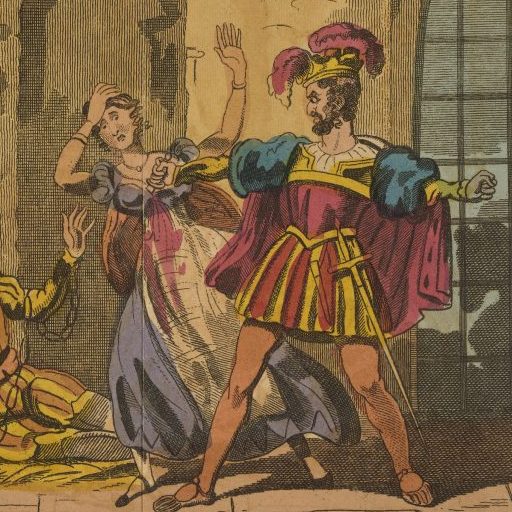The Witch of Ravensworth: A Romance
Author: George Brewer
Publisher: J. F. Hughes
Publication Year: 1808
Language: English
Book Dimensions: 2 volumes, each 10.5cm x 16.5cm
Pages: 2 volumes, 228 and 212 respectively
University of Virginia Library Catalog Entry, Sadleir-Black Collection: PZ2.B75 W 1808
Published in 1808 by an author of disputed identity—most likely George Brewer, but possibly J. N. Brewer—The Witch of Ravensworth is a tale of secrets and witchcraft that warns against great greed.
Material History
The Witch of Ravensworth: A Romance is a simple, unassuming novel in two volumes. On a shelf filled with other works, these volumes probably would not catch your eye. They are rather small and thin, each measuring 16.5 x 10.5 x 2 cm, and the spines simply say WITCH OF RAVENSWORTH in small gold font near the top, with thin golden lines above and below the title. If you were to pick it off the shelf, however, you would notice that despite the simplicity, the novel is of good quality and is well-maintained. Both volumes are bound in dark, wine-colored leather. The color is uniform, but the texture is not; the spines are encased by a softer, more supple leather, while the front and back are sturdier and more textured. The spines of both volumes are worn and slightly discolored at the top and bottom, but overall the binding has stood the test of time in both appearance and utility.
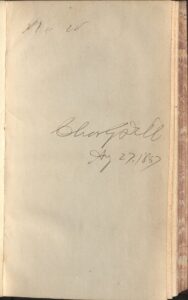
inscription from a previous owner.
The fore-edges and the interior covers (both front and back) have been marbled, a decoration technique in which paper is pressed into swirled paint to leave a design. The fore-edge marbling has a scale-like pattern of faded burgundy and yellow. The interior covers have the same scale-like design, but they are mostly rich burgundy interspersed with vibrant blue and beige. The marbling was likely commissioned by the owner after purchase rather than done by the publisher, indicating that the owner of this novel likely had money to spare.
Turning beyond the cover, the front free endpaper of both volumes contains a handwritten name and date, seemingly written in ink. The handwriting is large, loopy, and rather hard to make out. Part of the name may be “Charles,” but it is unclear. The date is “A? 27, 1887.” The inscriptions are the same in both volumes, so they clearly belonged to the same owner, indicating that the owner had enough money to spend amply on books.
Opening further to the title pages, both volumes have “The Witch of Ravensworth; A Romance, in Two Volumes” written in large font. “The Witch of Ravensworth” is underlined in pencil on the first volume, but the title page of the second volume has no added markings. Also included are the author (George Brewer), the volume number, and the publishing information (London: J.F Hughes, 15, Pater-Noster-Row, and 5, Wigmore-Street, Cavendish-Square. 1808.) in a smaller font beneath the title. The author’s name is surrounded by short decorative markings that draw the reader’s eye, and it notes that he is also the author of Hours of Leisure.
Flipping through the rest of the novel, the pages are in fairly good condition. The paper is textured and non-uniform, with small flecks dotted throughout the pages. Many pages have small, faded brown stains, and a few are slightly crinkled, but for the most part they are smooth, clear, and easy to read. The paper quality is well-maintained, as the pages are hardly brittle. Each page is numbered, and some contain “signatures” – letters and numbers (e.g. A1-6, B1-6, etc.) that help orient page numbering and proper folding of the book during printing. The text is rather large with wide spacing and large margins, and it is consistent throughout the entirety of both volumes. The chapter headers are listed in roman numerals and contain a short description of what occurs in the chapter.
Textual History
The Witch of Ravensworth: A Romance was originally published in London in 1808 by J. F. Hughes, though the author is disputed. The title page of the physical copy held in the Sadleir-Black Collection of Gothic Fiction at the University of Virginia lists the author as George Brewer. Many other sources also attribute the novel to George Brewer, including an 1808 advertisement in The Athenaeum, subsequent editions and translations of the novel, and Franz J. Potter’s The History of Gothic Publishing. Other sources, however, cite the author as J. N. Brewer, including A Biographical Dictionary of the Living Authors of Great Britain and Ireland, Montague Summers’ A Gothic Bibliography, and Thomas Meade Harwell’s The English Gothic Novel. Despite the shared surname, the Brewers do not appear to be related in any way. George Brewer was born to art connoisseur John Brewer and was baptized in 1766 in Westminster (Humphreys). J. N. Brewer, otherwise known as James Jupp Norris Brewer, was born to merchant James Brewer and was baptized in 1777 in Holborn (Haigh). Both men were authors who published several novels of varying genres in the late 1790s and early 1800s. James Norris Brewer wrote several romance novels that follow a similar titling convention to The Witch of Ravensworth, in which the main title is followed by “A Romance,” while George Brewer’s other works do not share this format (Humphreys, Haigh). Beyond title similarities, however, there is little to suggest that one is the more likely author of The Witch of Ravensworth, except the title page which clearly indicates George Brewer.
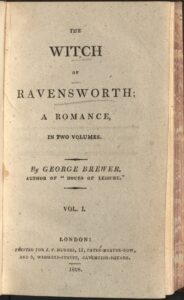
The novel was fairly well advertised following its publication in 1808. It is named under “Novels and Romances” in the list of new publications in The Monthly Magazine, The Athenaeum, and The Edinburgh Review, all of which list it for “10s.” The Athenaeum names the author as George Brewer, while The Monthly Magazine and The Edinburgh Review simply attribute the work to “Mr. Brewer.” Beyond newspaper ads, the novel is also advertised in catalogs present in the backs of other books, including Loiterings in America and The Life, Character, and Genius of Ebenezer Elliot, the Corn Law Rhymer. Both novels list The Witch of Ravensworth “At Ninepence Each (Cloth Gilt)” under “Miscellaneous Works,” though neither listing includes an author (Loiterings 148, Searle 196).
Despite the variety of advertisements, there is little information about how well the novel actually sold or whether or not it was popular with the general public, though there is a review in the December 1808 edition of Beau Monde, or, Literary and Fashionable Magazine. The reviewer has mixed feelings on the work: they note that it is “sufficiently interesting to keep the attention awake,” and they commend that there is a “good moral” that has been made “a part of the story instead of leaving it for the last page” (Beau Monde 288, 287). They also cite several passages as examples of good writing. The criticism lies mostly in the “improbability of the story,” including historical inaccuracies and Brewer’s overly exaggerated or hyperbolized descriptions (Beau Monde 288).
Interestingly, the novel was adapted into a play titled The Witch of Ravensworth; or, The Bridal Supper. It was produced at Surrey, Blackfriars Road in 1812, and advertisements for the performance can be found in The Times published on January 13, 1812 and January 14, 1812. There is no information on ticket sales or audience reception of the show, and it appears that no subsequent adaptations were made.
Following the original 1808 publication of the novel, a new edition was printed in 1842 in Durham by George Walker. A digital copy of this edition is available on Google Books, and a physical copy is held in the British Library Reference Collections. A more modern edition was published in 2006 by Valancourt Books, which can be found in sixty libraries worldwide, and physical paperbacks are available for purchase from the publisher. Perhaps this contemporary reprinting reignited interest in The Witch of Ravensworth, because a Hungarian translation and a Spanish translation were published in 2019 and 2020, respectively. The Hungarian translation, ǂA ǂravensworth-i boszorkány, is held by the Institute of Information Science, Izum, and the Library Cultural Centre Lendava, both located in Slovenia. The Spanish translation, La Bruja de Ravensworth, can be found digitally online through Proquest Ebook Central as well as physically for sale by Amazon and Casa del Libro.
Academic scholarship regarding The Witch of Ravensworth is primarily modern and encompasses a wide range of topics. Most works do not analyze the novel alone but cite it in analysis of trends in gothic literature as a whole. In “Gothic Revelations of Marriage in The Witch of Ravensworth and The Horrorsof Oakendale Abbey,” Monica Miller analyzes gothic depictions of marriage as a corrupt institution (31–9). Diane Long Hoeveler in The Gothic Ideology: Religious Hysteria and Anti-Catholicism in British Popular Fiction, 1780–1880 discusses how the popularity of witchcraft in British literature stems from anti-Catholic sentiment (21). In “Where the Evidence Leads: Gothic Narratives and Legal Technologies,” Hoeveler and James D. Jenkins analyze depictions of legal proceedings in gothic fiction, including The Witch of Ravensworth (321–22). Laurence Talairach, in Gothic Remains: Corpses, Terror and Anatomical Culture, 1764–1897, analyzes how changes in medical and anatomical history impact the depictions of death and corpses in gothic literature (Chapter 2 “The Chamber of Horrors: Anatomical Models and the Gothic”).
Narrative Point of View
The Witch of Ravensworth is narrated in third person past tense by an anonymous narrator who is not involved in the text or storyline. The sentences are often long and descriptive, though occasionally punctuated by very short statements. The narration feels somewhat old-fashioned but is not particularly archaic, and the language is clear and comfortable to read. There is a large enough focus on plot and action to keep the story moving forward at a satisfactory pace, but there are also frequent descriptions of the characters’ thoughts and feelings throughout the novel.
Sample Passage:
Oppressed, and sick at heart, the baron pursued the first path he came to, regardless whither he went: he began, now, to abhor the crimes that had produced only torment; he began to hate himself; he began to hate the fair promise of vice, that he had found to be a lie. (Brewer 2: 115)
The insight into the characters’ thoughts and feelings largely concerns the emotions and motivations of the Baron, the primary protagonist. The Baron’s actions are heavily driven by secret internal desires, so this information is necessary in order to fully understand and appreciate the storyline. Personal insights are given for other characters as well, including Lady Bertha, Lady Alwena, and the La Braunch servants. The descriptions of their emotions develop the complexity of their characters, but they do not reveal any important secrets, so the reader does not know any salient details that the Baron is not privy to and there is thus no dramatic irony. Notably, the Hag is perhaps the only primary character whose internal emotions are not revealed at any point. This maintains an air of mystery around her character and does not provide any hints of her true identity before it is revealed in the novel’s twist ending.
Summary
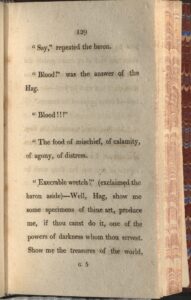
In the forest of Ravensworth is a small, run down hut where a stooped, ugly witch known as the Hag lives. Nobody in the surrounding villages knows when or where she came from, but they all avoid her in fear of her magic. Within a mile of the Hag’s hut is the castle of La Braunch. It is owned and inhabited by the Baron de La Braunch, a charming but manipulative and greedy knight who desires extreme wealth.
The Baron marries Lady Bertha, who has an infant son named Edward. During the wedding dinner, the festivities are derailed by the Hag, who cackles and toasts a curse to the bride. In time, Bertha has a son named Hugo born to the Baron. During the baptism ceremony, Hugo is brought in by a mysterious figure cloaked in black, who reveals herself to be the Hag. On the way out, the Hag speaks directly to the Baron, telling him to find her when he needs her.
The Baron loves Hugo but grows to hate Edward, Bertha’s first child by another man. The Baron hopes that Edward will die young, so that all of Lady Bertha’s fortune will go to Hugo instead and thus be directly inherited by the La Braunch family. He decides to visit the Hag to seek her aid in the matter. He questions her about Edward and Bertha, but the Hag will not give an answer and instead tells the Baron to return at midnight when ghosts and demons will be active.
Upon the Baron’s return, the Hag leads the Baron to a dark, vaulted chamber. The Hag conjures a grotesque demon and the specter of a woman to convince the Baron of her powers, and once he is satisfied they return to the hut. As payment, the Hag demands that the Baron bring her one of Bertha’s children. The next evening, the Baron steals Edward from his cradle while everyone in the castle is asleep and presents him to the Hag. The Hag performs a ritual with Edward and disappears, then reappears shortly holding a bloody knife in place of the child. She says that the Baron is now a servant of the demon Askar, and if the Baron returns he can ask Askar to fulfill his desires.
The following morning, Bertha is distraught when she discovers that Edward is missing. She blames the Hag’s curse during the wedding, and the Baron orders the servants to bring the Hag into custody. The Hag is questioned about the disappearance but denies any involvement, and they let her go due to lack of sufficient evidence of any crime.
Many years pass after Edward’s disappearance, during which Hugo dies from an illness. After Hugo’s death, the Baron meets Lady Alwena, who lives in a palace not far from the La Braunch castle. Lady Alwena is wealthy, beautiful, and beguiling, and the Baron becomes enamored with her. Now in love with another woman and without any remaining sons, the Baron decides to get rid of Bertha and seeks the Hag to help him do so.
The Hag tells the Baron that this time he must ask the demon for aid himself, rather than working through the Hag. She blindly leads the Baron to a dark chamber, where the demon Askar is seated on a throne. The Baron is initiated into the demonic mysteries, and Askar gives the Baron a scroll promising him the death of Lady Bertha and the possession of Lady Alwena. Lady Bertha goes missing soon thereafter.
The Baron soon proposes to Lady Alwena, and they hold an elaborate wedding. The Hag interrupts the dinner gala, but she says she has come to celebrate the marriage in good faith. In the months following the wedding, however, the Baron and Alwena grow angry with one another. The Baron is jealous of Alwena’s affair with a young knight, and Alwena resents the Baron’s attempt at controlling her.
The Baron visits the Hag to complain that he is miserable even with his new riches and beautiful wife. He finally begins to regret his crimes and is upset about trading his honesty and dignity for wealth. Upon leaving the Hag’s hut, the Baron looks for shelter from a storm and stumbles upon a cottage belonging to the poor woodcutter Gerrard, his wife Deborah, and his young apprentice, who take the Baron in for a short time.
In the following days, the Baron feels increasingly guilty and pained by his crimes, spending most of his time in a gloomy chamber in the western turret of the castle. One evening, he decides to distract himself with a formal dinner with Alwena, though they still have not reconciled. Having inherited wealth from the Baron, Alwena now wishes him dead to give her freedom to pursue her affairs, so she poisons the Baron’s wine during their dinner. The Baron realizes he is dying and gives his will to his servant, which states that all of his estates and riches will go to Gerrard, as long as Gerrard goes alone to the chamber in the western turret to find the title-deeds.
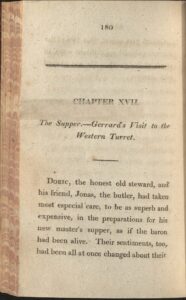
Gerrard ventures to the chamber, where he finds a woman’s corpse lying on a frame next to a cradle containing the body of an infant. He also finds a scroll proclaiming that the land was passed on through murder. Horrified, Gerrard runs from the chamber and gathers with Deborah and the La Braunch servants. They read through the rest of the scroll, which states that Edward and Bertha were murdered by the Hag through orchestration by the Baron. These were not the Baron’s first or only crimes, however; he had previously seduced a woman known as Lady Gertrude and poisoned her with help from a monk.
The Hag appears alongside two figures cloaked in black. Gerrard accuses her of murdering Edward and Bertha, but the Hag says she actually saved them. She claims that she took Edward and left him at a woodcutter’s cottage. The story and timeline align with when Gerrard took in an abandoned child to raise him as his apprentice, but Gerrard does not believe the Hag until she uncloaks the figures beside her to reveal Edward and Bertha! The Hag also reveals that the Baron is still alive. She had given the “poison” to Alwena during the wedding dinner, but the mixture was designed to put the Baron to sleep rather than kill him.
Although Edward and Bertha are alive, Gerrard still accuses the Baron of killing Lady Gertrude, as the scroll states. However, the Hag says that Gertrude is alive as well. The Hag removes an ugly mask from her face and reveals herself to be Gertrude! She explains that she posed as the Hag to avenge the Baron’s wrongs against her and to save others from his designs. She had once been engaged to the Baron, but their marriage ceremony was false. Gertrude planned to appeal this to the king, but the Baron decided to poison her and enlisted a monk to aid him. The monk delivered a fake poison, so Gertrude survived and lived in secret in the forest. She dressed as the Hag and heard the plans of the Baron, so she was able to interfere and save Edward and Bertha.
After the truth is revealed, Gerrard gives up the possession of the La Braunch castle to Edward, the true heir. Edward allows Gerrard and Deborah to live in the castle with him. Gertrude retires to a convent to spend the rest of her life in peace, and the Baron commits to a monastery to repent for his attempted crimes.
Bibliography
Aikin, John. “Monthly List of New Publications. Novels and Romances.” The Athenaeum: a magazine of literary and miscellaneous information, May 1808, p. 467.
A Biographical Dictionary of the Living Authors of Great Britain and Ireland; comprising literary memoirs and anecdotes of their lives, and a chronological register of their publications, with the number of editions printed; including notices of some foreign writers whose works have been occasionally published in England. London, Henry Colburn, 1816.
Brewer, George. The Witch of Ravensworth: A Romance. London, J. F. Hughes, 1808.
Brewer, George. La Bruja de Ravensworth, translated by Alfonso Boix Jovani, edited by Eva Lara Alberola and Alfonso Boix Jovani, Madrid, Siruela, 2020.
Brewer, George. ǂA ǂravensworth-i boszorkány, translated by Sándor Kiss, Mátrabesenyő, Attraktor, 2019.
Brewer, George. The Witch of Ravensworth, edited by Allen W. Grove, Chicago, Valancourt Books, 2006.
Brewer, George. The Witch of Ravensworth, A Romance. Durham, George Walker, 1842.
Haigh, John D. “Brewer, James Jupp Norris (1777–1839), novelist and topographer.” Oxford Dictionary of National Biography. Oxford University Press, 24 October 2019. https://doi.org/10.1093/ref:odnb/3362
Harwell, Thomas Meade. The English Gothic Novel: Contexts. Austria, Inst. für Anglistik u. Amerikanistik, 1986.
Hoeveler, Diane Long. The Gothic Ideology: Religious Hysteria and Anti-Catholicism in British Popular Fiction, 1780–1880. University of Wales Press, 2014.
Hoeveler, Diane Long, and James D. Jenkins. “Where the Evidence Leads: Gothic Narratives and Legal Technologies.” European Romantic Review, Volume 18, Issue 3: Romanticism and Law, 2007, pp. 317–37.
Humphreys, Jennett, and Rebecca Mills. “Brewer, George (bap. 1766), writer.” Oxford Dictionary of National Biography. Oxford University Press, 23 September 2004. https://doi.org/10.1093/ref:odnb/3361
Jeffrey, Francis Jeffrey. “Quarterly List of New Publications. Novels and Romances.” The Edinburgh Review, January 1809, p. 506.
“List of New Publications.” The Monthly Magazine; or, British Register, 1 November 1808, p. 370.
Loiterings in America. London, Charles Gilpin.
Miller, Monica. “Gothic Revelations of Marriage in The Witch of Ravensworth and The Horrors of Oakendale Abbey.” Studies in Gothic Fiction, Volume 1, Issue 1, 2010, pp. 31–40.
Potter, Franz J. The History of Gothic Publishing, 1800–1835: Exhuming the Trade. Palgrave Macmillan, 2005.
Searle, January. The Life, Character, and Genius of Ebenezer Elliot, the Corn Law Rhymer. London, Charles Gilpin.
Summers, Montague. A Gothic Bibliography. London, The Fortune Press, 1964.
“Surrey Theatre.” The Times (London, England). 13–14 January 1812.
Talairach, Laurence. Gothic Remains. Corpses, Terror and Anatomical Culture, 1764–1897. University of Wales Press, 2019.
“The Witch of Ravensworth, A Romance: In Two Volumes.” Beau Monde, or Literary and Fashionable Magazine, December 1808, pp. 286–88.
Researcher: Taioli Ferree
How to cite this page:
MLA: “The Witch of Ravensworth.” Project Gothic, University of Virginia, 2024, https://gothic.lib.virginia.edu/access-the-archive-2/the-witch-of-ravensworth/
